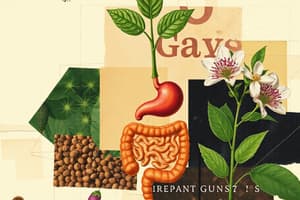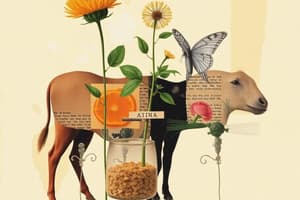Podcast
Questions and Answers
Which element is commonly seen in modern web design for enhancing user experience?
Which element is commonly seen in modern web design for enhancing user experience?
- Animations and transitions (correct)
- Static images
- Old browser compatibility
- Text-only content
Images do not play a significant role in web design.
Images do not play a significant role in web design.
False (B)
What is the primary function of CSS in web development?
What is the primary function of CSS in web development?
Styling web pages
The use of ______ in web design can make a website more interactive and engaging.
The use of ______ in web design can make a website more interactive and engaging.
Match the following web design elements with their characteristics:
Match the following web design elements with their characteristics:
Flashcards
String
String
A sequence of characters used to represent text. It can be a single character, a word, or a sentence. It is used to store and represent information in a computer program.
Quotation marks
Quotation marks
A special symbol that indicates the start and end of a string. It is commonly used in programming languages to define literals.
ASCII code
ASCII code
A way of representing a character or group of characters using a numerical code. The standard ASCII code assigns unique numbers to each character, allowing computers to process and store them efficiently.
Case conversion
Case conversion
Signup and view all the flashcards
Word
Word
Signup and view all the flashcards
Study Notes
Plant Nutrition
- Plants need water, carbon dioxide, and sunlight to produce carbohydrates (glucose).
Parasitism
- Some plants are insectivorous, using specialized leaves to attract and trap insects for digestion.
- Venus flytrap is an example.
Nutritional Adoption in Animals
- Animals are heterotrophs, meaning they obtain nutrients by consuming other organisms.
- Dietary categories include herbivores (plant eaters), carnivores (meat eaters), omnivores (both), and detritivores (decomposers).
Intracellular vs. Extracellular Digestion
- Intracellular digestion: Single-celled organisms (like protists) digest food inside their cells.
- Extracellular digestion: In multicellular organisms, food particles are broken down outside cells before being absorbed.
Substrate Feeders
- Single-celled organisms process food inside their cells.
Bulk Feeders
- Eat large food chunks, using adaptations such as jaws, teeth, tentacles, or claws for intake and processing.
- Examples: snakes and cats.
Five Stages of Animal Food Processing
- Mechanical Processing/Ingestion (chewing, swallowing)
- Secretion of Enzymes (digestive aids)
- Enzymatic Hydrolysis (chemical breakdown)
- Absorption (nutrient uptake)
- Elimination (waste removal)
Nutrition's Role in Organism's Life
- Nutrients enable organisms to fight disease and produce resistance against illness.
- Nutrients build and repair cells, sustain bodily functions (including breathing), and enable reproduction.
Types of Organisms Based on Nutrition
- Autotrophs (self-feeders): Organisms that produce their own food using sunlight or chemicals.
- Examples: plants and chemosynthetic bacteria
- Heterotrophs: Organisms that cannot produce their own food and obtain it from other organisms.
- Examples: animals and fungi
Plant Oxygen Needs
- Plants obtain oxygen from air spaces in soil. Proper cultivation is necessary for adequate oxygen supply.
Macronutrients and Micronutrients for Plants
- Plants primarily need 0.5% macronutrients (carbon, oxygen, hydrogen, etc.) and trace amounts of micronutrients (chlorine, iron, etc.).
- Deficiencies in these nutrients can lead to stunted growth or discoloration.
Symbiotic Relationships in Plants and Soil Microbes
- Symbiotic interactions between nitrogen-fixing bacteria and legume plants are crucial for nutrient acquisition.
Symbiosis of Plants and Fungi
- Mycorrhizal fungi extend the root system, enhancing nutrient (especially phosphorus) uptake.
- Transfer of nutrients like zinc and copper from the fungi to the plants enhances their wellbeing.
Oxygen Use in Plants
- Oxygen is crucial for cellular respiration, releasing energy from sugars (carbohydrates) for plant growth and bodily processes.
Filter Feeders
- Aquatic animals that filter small particles from water for nutrition.
- Examples: whales and certain cnidarians.
Studying That Suits You
Use AI to generate personalized quizzes and flashcards to suit your learning preferences.




